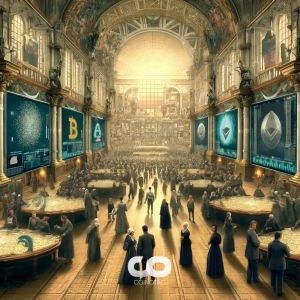From Tokens to Access: How Web3 and Mirror Links Are Reshaping Digital Freedom
4 min read
For years, “Web3” has been synonymous with speculation—an ecosystem dominated by NFTs, memecoins, and volatility. But beneath the noise of token trading and decentralized finance hype, a quieter, more revolutionary movement is taking root. One that’s less about wealth—and more about access. In places where digital repression is the norm and online platforms bend to state control, the technologies that underpin Web3—blockchains, decentralized storage, peer-to-peer protocols—are merging with another unlikely ally: mirror links . Together, they are laying the foundation for a freer internet—one that resists censorship not through protest, but through architecture. Welcome to the next frontier of digital freedom, where tokens don’t just represent value—they represent entry. Web3’s Unintended Superpower The first wave of Web3 was about ownership—owning your assets, your identity, your data. But in censored markets—from Iran and Myanmar to Russia and parts of Sub-Saharan Africa—Web3 is taking on a more urgent mission: keeping the internet open when the walls close in. At the core of this evolution is decentralization. Web3 technologies are inherently resistant to control because they operate outside traditional gatekeepers. Smart contracts don’t live on corporate servers. DAOs (Decentralized Autonomous Organizations) don’t respond to government subpoenas. And decentralized applications (dApps) don’t vanish when an app store delists them. This matters because censorship today is less about outright bans and more about chokepoints: app removals, domain blocks, surveillance, and payment restrictions. Web3 rebuilds the web from the ground up without those chokepoints. Mirror Links: The Bridge Between Old and New While Web3 provides the backend resistance, mirror links offer the frontline access. These are alternate URLs—clones or proxies—that replicate a blocked website’s content on a different domain. Frequently used in regions where authorities block popular news outlets, social platforms, or even crypto exchanges, mirror links are an old trick with new relevance. And when these mirror links are paired with Web3 infrastructure, they become even more powerful. For example: A mirror link can point to a dApp frontend hosted on IPFS, making the site immune to takedowns. Decentralized domains (like those registered through ENS or Handshake) can be used as mirror destinations, bypassing centralized DNS entirely. Users can receive real-time updates of working mirrors via encrypted Web3 messaging protocols like XMTP or Lens. Digital Identity and Permissionless Access Traditional internet access is increasingly tied to identity—phone numbers, SIM registration, KYC, IP tracking. In censored countries, this can lead to blanket surveillance or targeted harassment. Web3 disrupts this through self-sovereign identity (SSI) models. Users authenticate via cryptographic wallets, not real-world documents. In this new model: A user in Iran can access an educational dApp without revealing their name or location. A journalist in Russia can publish investigative content to IPFS via a DAO, using a pseudonymous Ethereum address. A citizen in Ethiopia can receive stablecoin remittances tied to a wallet—not a bank. This kind of permissionless participation is impossible in Web2 environments, where every access point is controlled. In Web3, your wallet is your passport—and no one can cancel it. Censorship Resistance by Design Web3 apps don’t just operate differently; they resist differently. Here’s how: Content Hosting on IPFS and Arweave: Instead of a server, data is stored across a distributed network. Censoring one node does nothing. Decentralized Frontends: Tools like Fleek or Skynet allow websites to deploy on decentralized hosts, making mirror creation automatic. DNS Alternatives: ENS (.eth) and Handshake (.hns) domains live on blockchains, immune to seizure by ICANN or local ISPs. Token-Gated Access: Some platforms use NFTs or tokens as keys to gated services—bypassing traditional login systems and surveillance traps. Even when governments block access to crypto or dApp services, VPNs, browser extensions, and rotating mirror URLs keep the doors open. Real-World Adoption: Quiet but Growing While many in the West debate regulatory frameworks, users in restricted environments are already adopting Web3 out of necessity—not choice. In Nigeria, P2P stablecoin markets are thriving among freelancers and students facing inflation and fintech crackdowns. In China, developers experiment with blockchain-based publishing tools to preserve censored stories and whistleblower reports. In Ukraine and Venezuela, DAOs have become fundraising tools to bypass banking restrictions and coordinate aid. In these cases, tokens become tools, and mirror links become lifelines. Risks, Challenges, and the Road Ahead Of course, this isn’t a utopia. Web3 comes with risks—rug pulls, scams, UX friction, and government pushback. Tools like IPFS are still too technical for most users. Wallet recovery remains a pain point. And mirror links, while useful, can be short-lived without constant maintenance. But the direction is clear: access is becoming decentralized. Where the old internet fails under pressure, the new one bends and adapts. Where content is blocked, it’s mirrored. Where users are tracked, they are anonymized. Where speech is banned, it is tokenized and distributed. Conclusion: A New Internet for the Next Billion Web3 is no longer just about speculation or protocol upgrades. It’s becoming a humanitarian technology stack—a way to bring connectivity, agency, and financial freedom to people who’ve been locked out of the traditional web. In the new paradigm, mirror links are more than circumvention tools. They’re bridges.Tokens are more than speculative assets. They’re passports.And Web3 is more than an evolution. It’s a reclamation—of access, autonomy, and voice. As censorship grows more subtle and more technical, so too must the resistance.And right now, that resistance is being coded into the very fabric of the decentralized web. Disclaimer: This article is provided for informational purposes only. It is not offered or intended to be used as legal, tax, investment, financial, or other advice.

Source: Crypto Daily



